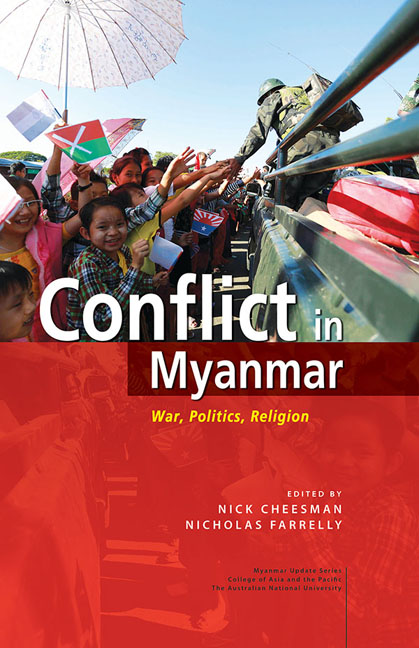Book contents
- Frontmatter
- Contents
- List of Maps
- List of Tables
- List of Figures
- Acknowledgements
- Contributors and Editors
- Part I Introduction
- Part II War and Order
- Part III Elections and After
- Part IV Us and Them
- 12 Making sense of reactions to communal violence in Myanmar
- 13 Public perceptions of a divided Myanmar: Findings from the 2015 Myanmar Asian Barometer Survey
- 14 On Islamophobes and Holocaust deniers: Making sense of violence, in Myanmar and elsewhere
- 15 Buddhist welfare and the limits of big ‘P’ politics in provincial Myanmar
- 16 Threat perceptions in the Myanmar–Bangladesh borderlands
- Part V Conclusion
- Abbreviations and Key Terms
- Index
16 - Threat perceptions in the Myanmar–Bangladesh borderlands
from Part IV - Us and Them
Published online by Cambridge University Press: 22 July 2017
- Frontmatter
- Contents
- List of Maps
- List of Tables
- List of Figures
- Acknowledgements
- Contributors and Editors
- Part I Introduction
- Part II War and Order
- Part III Elections and After
- Part IV Us and Them
- 12 Making sense of reactions to communal violence in Myanmar
- 13 Public perceptions of a divided Myanmar: Findings from the 2015 Myanmar Asian Barometer Survey
- 14 On Islamophobes and Holocaust deniers: Making sense of violence, in Myanmar and elsewhere
- 15 Buddhist welfare and the limits of big ‘P’ politics in provincial Myanmar
- 16 Threat perceptions in the Myanmar–Bangladesh borderlands
- Part V Conclusion
- Abbreviations and Key Terms
- Index
Summary
Many complexities that symbolize Myanmar today stem from its borders, border people, and border regions. From Karen and Shan in the east to Kachin and Wa in the north, to Chin and Rakhine in the west, Myanmar's periphery commotions affect its stability and its peace conditions (ICG 2015). Researchers have studied these phenomena, and their approaches range from queries on Myanmar's borders (for example, Cohen 2013; Morshed 2012; Schendel and de Maaker 2014) to nuanced studies on border people, policies, and regions (notably, Chen 2014; Farrelly 2012; Pate 2010).
The way peripheries have dominated Myanmar's future brings to the fore some old questions: what are the causes of conflicts at these outer regions? How do they relate to border administration, and how do the security echelons operating on either side of the border perceive threats? Do these assessments come from physical, tangible elements of fear? Or do they draw from intangible and often imperceptible fear factors like religion, ethnicity, cultures, and languages of the bordering people?
In this chapter I address some of these queries, using the case of the Rohingya in Rakhine State. Despite a long period of neglect, the story of the Rohingya is increasingly finding an audience in the political arena as well as in academia, and yet the Rohingyas’ plight is far from being alleviated. A discussion of the Rohingya offers scope for analyzing not only Myanmar's governance at the fringe areas but also performances by their Bangladesh counterparts, and sheds light on the attendant border management by these respective countries.
Since a number of scholars have delved into ethno-religious issues (Siddiqui 2011), socio-political affairs (Shwe Lu Maung 1989), and nontraditional security matters (Ahmed 2010) relating to the Rohingya, in this chapter I focus on two aspects of traditional security: border management and the conception of threat by the opposing forces of Myanmar and Bangladesh. Drawing examples from past conflicts along the border — and juxtaposing them with findings from the field — I question the way borders are typically managed and the threats constructed. My experiences of past service in this borderland region — with the Bangladesh Army in the early years of the twenty-first century (in areas opposite north-western Rakhine State) and subsequently with the Border Guards during the close of its first decade (in areas west of River Naaf) — help me in this assessment.
- Type
- Chapter
- Information
- Conflict in MyanmarWar, Politics, Religion, pp. 333 - 350Publisher: ISEAS–Yusof Ishak InstitutePrint publication year: 2016

